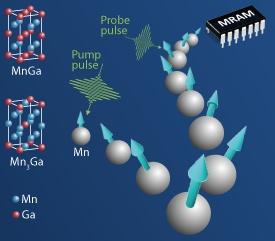

05/30/2011

Magnetic materials continue to be the dominant storage system for computers. The continuing demand for increased storage densities has resulted in ever-smaller magnetic bits, but as the bits become smaller, the long-term stability of the stored data begins to suffer. In the search for novel materials with enhanced long-term magnetic stability, a team led by researchers from the WPI-AIMR1 has now discovered that an alloy of manganese and gallium is not only a strong magnet but also has switchable magnetization with low loss — a key requirement for fast, low-power non-volatile magnetic memory.
There are two important requirements for magnetic memory. One is the stability of the magnetic orientation of a domain, a property known as magnetic anisotropy. High magnetic anisotropy is needed to ensure that information, in the form of magnetic orientation, can be retained. The other property is magnetic friction, which describes the losses associated when changes are made to the magnetization direction. “The larger the magnetic friction, the higher the electric power required to record digital information,” explains Shigemi Mizukami from the research team.
Similar to any other friction process, magnetic friction can be measured through the slowing of motion. Here, it is the slowing of the precession of magnetization around an axis, similar to the movement of a spinning top when knocked off center (see image). And like spinning tops, this magnetic precession can be set in motion through an external force — in this case by an ultrashort laser pulse. The slowdown of the precession after a given amount of time can be probed by a second laser pulse, which allows the magnetic friction coefficient to be calculated.
So far, all materials with high magnetic anisotropy had also shown a large magnetic friction coefficient. For these manganese–gallium alloys, however, the researchers found the magnetic friction to be surprisingly low. Theoretical calculations indicate that this reduced friction is caused by a very low density of available electronic states at the topmost electron energies in the material. This means simply that there are relatively few empty states available for electrons to move into as a consequence of magnetic scattering, creating a bottleneck through which magnetic friction is suppressed.
This discovery offers unique promise for future magnetic random-access memory devices, comments Mizukami. “Other than this alloy, there are no magnetic materials that show both low magnetic friction and high magnetic anisotropy. This combination of properties will be key in developing a replacement for existing computer memories."
Mizukami, S., Wu, F., Sakuma, A., Walowski, J., Watanabe, D., Kubota, T., Zhang, X., Naganuma, H., Oogane, M., Ando, Y. & Miyazaki, T. Long-lived ultrafast spin precession in manganese alloys films with a large perpendicular magnetic anisotropy. Physical Review Letters 106, 117201 (2011). | article
This research highlight has been approved by the authors of the original article and all information and data contained within has been provided by said authors.